Text
Claire Marino 3/13/19 Readerly Exploration
Due: 3/13/19
Title: Chapter 9
Big Takeaway: When students understand text factors, such as genre, structure, literary devices, text features, and formats, they can use them to help with comprehension of new texts.
Nugget: Text factors associated with genre are assessed on students’ ability to identify them, but not always on how they can be used for a comprehension strategy.
Readerly Exploration:
Read a wide variety of genres and formats of texts to grow in their knowledge and experiences as a reader + Get inspiration from the assigned course reading(s) to find and read another text from a different genre or format and connect the two in some way.
While I was reading this text, I was thinking about how the knowledge of text factors is really necessary for comprehending different texts. I thought of a book that I am currently reading and how I have had to use this knowledge of text factors to read it meaningfully. I have been slowly working through The Crossover, by Kwame Alexander for a few months now. I only read a few pages here and there, usually at night, and have noticed that I usually need to make a switch in the way I read before I begin. The book is a collection of poems that tells the greater story in a novel format. When I transition from reading a textbook for a class to reading The Crossover, I need to remember the formats of poems as well as the poetic devices that are used. I think there is something to be said for the “rhythm” that poems evoke when reading, and how this is different than other genres. Understanding the text factors of poems is essential to comprehending this book. Reading it like a regular novel without appreciating poetic devices would miss some meaningful parts of the story. Associating this practice of teaching text factors with a book I am reading outside of class helped me to see how impactful it can be. I see the importance of teaching these factors as comprehension strategies, beyond just identifying the characteristics of a genre for the sake of doing so.

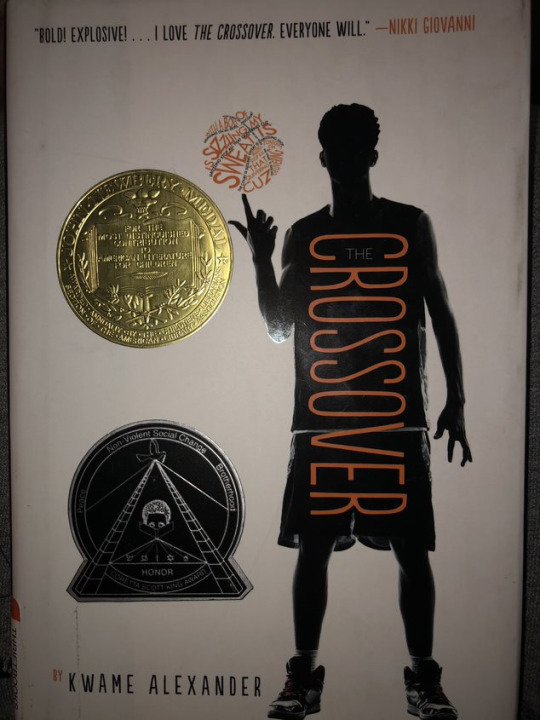
Above are pictures of the cover of The Crossover and a poem from the book.
1 note
·
View note
Text
Claire Marino- 3/11/19 Readerly Exploration
Due: 3/11/19
Title: Chapter 8
Big Takeaway: There are certain factors that promote successfully comprehending text, including background knowledge, vocabulary, fluency, strategies, skills, and motivation.
Nugget: Giving students opportunities to feel competent in what they do leads to increased motivation.
Readerly exploration: Engage in the reading process to increase the likelihood of text comprehension (pre-reading, reading, responding, exploring, applying) + As you read, annotate any questions that arise for you in the margins.
For this readerly exploration, I decided to annotate questions as I read through the text. Since I have the online version of this textbook, I just annotated questions that came up in the margins of my notes. This chapter, about reader factors that affect comprehension, was very straightforward. Because of this, I found myself not asking as many questions as I expected. At least compared to other readings, this one did not appear very theoretical. Instead, it provided strategies to increase comprehension in students. Because of this, I began to think about how this would connect to specific students that I have or have had in classes. I found questions when I thought about how these factors would apply for them. An example of one of these questions was about fostering intrinsic motivation. Collaboration was one of the main ways to increase motivation in students, along with choices, expectations, and competence. I have met few, but still some, students who prefer to work alone most of the time and become less engaged when collaboration is needed. I wondered if collaboration was a motivating factor for all students. When I think about these students, I think that authentic collaboration with support is needed for it to be motivating. By coming up with these questions as I read, I was able to make connections with real students. This was valuable because I may not have done this as readily if I had not picked this readerly exploration. We know that making connections is essential for making meaning of learning, so this was very helpful.
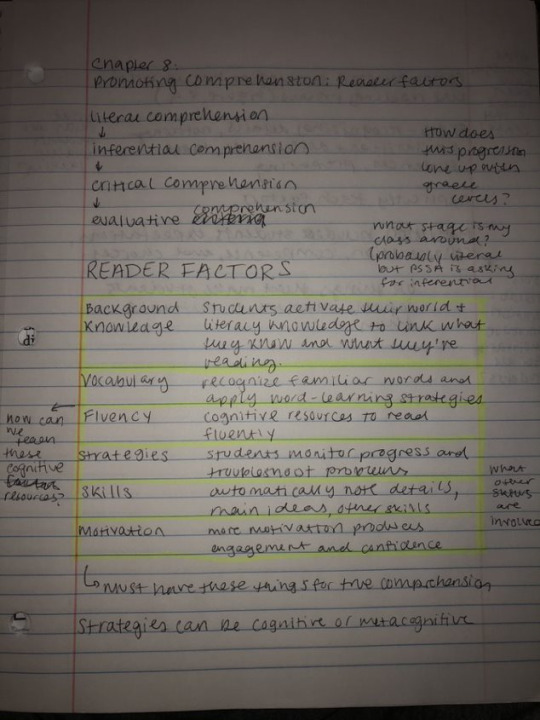

Pictured above are some examples of questions I developed while reading.
1 note
·
View note
Text
Claire Marino- 2/27/19 Readerly Exploration
Due Date: 2/27/19
Title: Chapter 10 and 7 Rules of Engagement
Takeaway (Chapter 10): Different ways of organizing literacy instruction have different benefits and draw backs when it comes to integrating reading and writing in the intermediate grades.
Takeaway (Gambrell): Intrinsic motivation is one of the most contributive factors to literacy success, and should be prioritized in literacy instruction.
Nugget (Chapter 10): I thought that literature focus units were an interesting way to motivate students, and could be beneficial for including reading and writing.
Nugget (Gambrell): Student motivations to read are closely tied to reading performance.
Readerly Exploration:
Engage in the reading process to increase the likelihood of text comprehension (pre-reading, reading, responding, exploring, applying) + After you read, sit down with a classmate after you have both done the assigned reading and discuss what you found to be the most compelling about what you read and the least compelling.
While I was reading this article and chapter, I realized that Kayla Flemmens, who is my roommate, was sitting across the room reading the same thing. We engaged in discussion about the readings for a few minutes until we realized that we should wait until we were finish reading to talk about it as a readerly exploration of the text. We discussed our different perceptions about the different ways to organize literacy instruction, and how it differed in the primary and intermediate grades. I explained how reading and writing workshop applied in primary grades, as well as basal reading programs. It was interesting to see the shift between these grades and the function of these ways of organizing. I shared that I had developed a negative perception of basal readers, and was surprised to see an example of a classroom where they were used in an engaging and motivating way. In talking about the Gambrell article, we both were struck by one claim, that intrinsic motivation for reading was linked to better reading performance. We both wondered which of these came first. Did students do poorly in reading, and thus did not enjoy it going forward, or did students not enjoy reading and then did poorly because of that lack of motivation. The article clearly argued for the latter, but it is interesting to consider that side of things. This discussion, of which this paragraph only notes the highlights that were discussed, was beneficial to my understanding of the readings. By getting Kayla’s perspective, I was able to see more clearly how these methods would look in intermediate and even middle grades. I think this was very important for getting me out of my primary-grades context for literacy instruction, so that I can learn more about how to teach literacy in intermediate grades.

1 note
·
View note
Text
Claire Marino- 2/25/19 Readerly Exploration
Due: 2/25/19
Title: Chapter 1: Becoming an Effective Literacy Teacher
Takeaway: Effective teachers of literacy possess the nine principles laid out in this chapter, each encompassing necessary knowledge of pedagogy and literacy instruction.
Nugget: I hadn’t thought about principle two (drawing on all four cueing systems) as something that was ascribed to an effective literacy teacher, but now I see how literacy instruction really isn’t complete without including time to practice and learn each cueing system.
Explore relationships with other people through reading by using texts as a shared experience with another person/other people or to gain insight into the perspective of another person + Create a character sketch of someone you know that represents the big ideas of the assigned course reading(s) in some way and share with that person.
For this readerly exploration, I decided to do a character sketch of my mom, who I believe possesses the characteristics of an effective literacy teacher as outlined in this chapter. As a teacher of 25 years, some of which were spent as a literacy specialist for her district, she has grown in her expertise on the subject of literacy instruction. As I went through the chapter and reflected on possible connections to my mom, I was forced to think about how each of the principles would look in a classroom. For example, I thought about if the times I had watched her teach literacy skills promoted a balanced approach, and if there were opportunities to build students’ knowledge in each cueing system. I concluded that this could look a lot of different ways, but the way that I saw my mom use it was through the consistent integration of reading and writing as well as prioritizing time for spoken language to develop. By having to consciously make this visualization for my character sketch, I can better see how these principles could work in myself as a teacher. This personalization that comes with envisioning characteristics was a beneficial experience that I would not have had without making the sketch. I shared this sketch with my mom through text message, and she was touched that I thought of her. I can see how doing this as a reader in the future could increase comprehension of text and increase the likelihood of personal application.

2 notes
·
View notes
Text
Claire Marino- 2/18/19 Readerly Exploration
Title: Literacy for the 21st Century Chapters 2 and 6
Due: 2/18/19
Takeaway (Chapter 2): Both reading and writing are dependent on their processes, which make the activity meaningful.
Takeaway (Chapter 6): Reading and writing fluency is composed of several skills and is needed for overall success in literacy.
Nugget (Chapter 2): Editing and revision are separate processes that require revising different parts of the writing.
Nugget (Chapter 6): Dysfluency is something that needs to be addressed when it continues to impact students in intermediate grades and higher.
Readerly Exploration: Engage in the reading process to increase the likelihood of text comprehension (pre-reading, reading, responding, exploring, applying) + After you read, document your initial response to what you’ve read. Consider how the ideas you read about made you feel and what they made you think about.
For this reading, I decided to document my initial response after reading the chapters. I did not realize that this fell into the reading process that this chapter was about, but it seems appropriate to do an exploration from this readerly habit for this reading! After I read each chapter, I stopped to write down my thoughts and feelings based on the information I learned. In this reflection, I realized how much of my reaction was associated with comparing the new information to my own experiences in school. In the first chapter, particularly, memories of going though reading and writing processes flooded my mind. Both negative and positive feelings characterized by experiences. One that was particularly enlightening was my experience with revising writing. I remember specifically being required to make a certain amount of edits on my own papers, and make sure I corrected a certain amount of errors when reviewing others’ papers. It felt very forced and I remember quickly learning the formulaic nature of the task and how to complete it in the quickest way possible. Reflecting on this in my initial thoughts was helpful for me to understand the importance of communicating the meaning behind these processes to students. If I had known that editing was part of what real writers did, and we completed it in a more authentic way, my attitude may have improved—and my writing certainly would have as well. I believe documenting these feelings on paper helped me to better understand the main ideas of these chapters. I think that going forward, I will remember my experiences and feelings in connection to these main ideas, which will make the processes more meaningful.
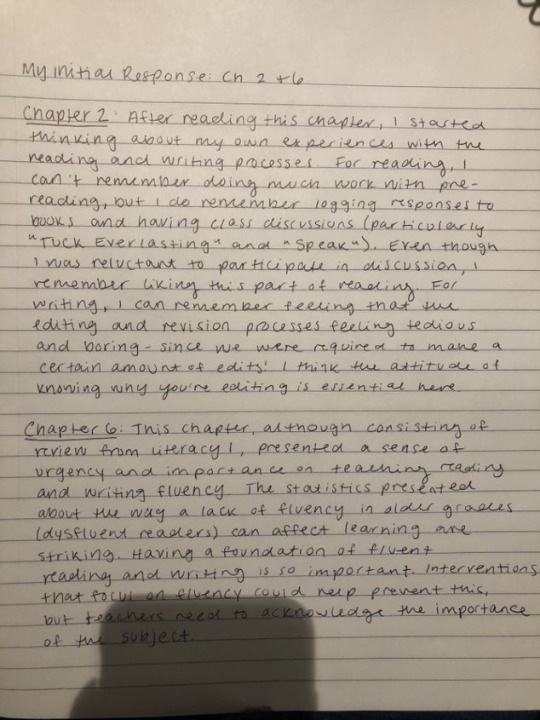
2 notes
·
View notes
Text
Claire Marino- 2/11/19 Readerly Exploration
Due Date: 2/11/19
Title: Literacy for the 21st Century Chapters 3 and 11
Takeaway (Chapter 3): Assessment is a vital part of literacy instruction and should be used in both evaluative and diagnostic ways in order to best support students.
Takeaway (Chapter 11): Differentiated Instruction is beneficial for all students, and should be personally rigorous, relevant, flexible, and complex.
Nugget (Chapter 3): There are several “readability formulas” that are in use to identify levels of books. The combination of analysis of vocabulary, genre, organization, and many other factors is very interesting.
Nugget (Chapter 11): Figure 11-3 provided many ideas for working through common reading and writing difficulties in the intermediate grades through intervention. These can be used to plan differentiated instruction for students.
Readerly Exploration: Explore the world through reading by using texts to answer questions about the world or generating new questions about the world from texts that are read + Make a list of three or four questions about literacy classrooms that come up for you as you read. Then, do some preliminary research on one of them.
For this readerly exploration, I decided to write questions that came about while reading these two chapters and do research on one of them. The three questions that came to mind while reading were:
· How do self-assessments interact with the self-efficacy or self-perception that ELs’ have of themselves? Does cultural differences in value for achievement affect this?
· Should teaching the “language of testing” be a priority in literacy classrooms or can more holistic word knowledge instruction cover this?
· Chapter 3 suggests that despite perceived displeasure with America’s school system, the achievement gap between groups is declining. Is this pattern continuing today? Is there a more recent study that details the current achievement gap?
The question that stuck with me the most after reading was about the achievement gap that is being measured by standardized tests. One of the main focuses of chapter 3 was how this testing affects the literacy classroom, and therefore how we teach students. I was curious about current statistics relating to the achievement gap and if it is really decreasing. Further than that, I wondered what practices are propelling and hindering closing this gap. In the National Assessment of Education Progress report from 2017, statistics show a continuous, but slight, decrease in the achievement gap between white students and black students for decades. The figure below shows this as well as gaps with other minority groups. To put this growth in tangible terms, the author of the article explains that, “…students in late elementary grades grow at a rate of around 0.3-0.5 standard deviations per year (although this varies across tested grades and subjects). Reducing the achievement gap by 0.2 standard deviations could be loosely interpreted as reducing the gap by about a half-year of typical academic instruction.” (Hansen) This research helped reinforce the current importance of these tests, and their use for recording gaps between groups of students. I had not thought about how learning test taking strategies is connected with teaching literacy. This has also encouraged my curiosity about what practices are working to close this gap and how to continue them.
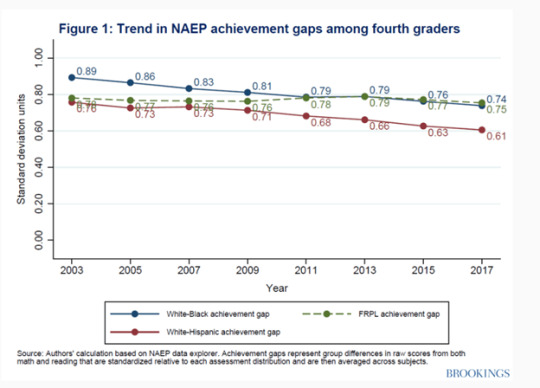
Hansen, M., Mann, E., Quintero, D., Valant, J., Hansen, M., Mann, E., . . . Valant, J. (2018, April 17). Have we made progress on achievement gaps? Looking at evidence from the new NAEP results. Retrieved February 9, 2019, from https://www.brookings.edu/blog/brown-center-chalkboard/2018/04/17/have-we-made-progress-on-achievement-gaps-looking-at-evidence-from-the-new-naep-results/
2 notes
·
View notes
Text
Claire Marino 2/8/19 Readerly Exploration
Due Date: 2/8/19
Title: Advanced Readers in Reading First Classrooms: Who Was Really “Left Behind”? Considerations for the Field of Gifted Education
Takeaway: Students differ in their needs for reading instruction and basal reader programs, like the ones implemented in Reading First classrooms, are not effective in meeting the needs of advanced readers.
Nugget: Ability grouping for advanced students is not effective unless authentic differentiation methods are in place. Simply separating them and giving more independence, asking higher order questions, or other adjustments is not effective in producing growth.
Readerly Exploration:
Read texts deeply in order to interpret, critique, and analyze the various layers of meaning a text might offer a reader + Identify a major current event/headline happening at the time the article was published to consider how the text might have been conceived or received.
For this Readerly exploration, I decided to think about the historical context of this article and the impact it may have had on audience reception. When I saw the title of this article, I knew that this would be valuable to look at. The quotation marks around “Left Behind” were an obvious nod to the No Child Left Behind Act that was passed in 2001. The date of publication, however, gave some interesting insights to how this act would apply to current educational discourse. This article was published in 2015, which was the same year that NCLB, although previously reinstated, was fully replaced by a new law. The Every Student Succeeds Act was just beginning at the time this was published, so it makes sense that a criticism of NCLB would be received. I think that, in this context, this article might have opened educators’ eyes to a different gap in the education system. Gifted education, specifically for advanced readers, was an area that this study showed to be clearly neglected by the curriculum under NCLB. I imagine this sparked an interest to see if the new law would remedy these problems, placing emphasis on differentiation for all students. Reading this nearly four years later, the idea that basal reader curricula does not serve all students well was not unfamiliar to me. I think that, although many schools still use this kind of core curriculum, this shift towards differentiation and not aiming to teach the “average” student is beginning to occur.


2 notes
·
View notes
Text
Readerly Exploration #8- Claire Marino- 10/19/18
Readerly Exploration #8
Due: 10/19/18
Readings: Talking Back and Forth and Over (Sipe)
Before you read, skim the assigned course reading for unfamiliar terms. Then, take the time to look up definitions to those terms.
Big Take-away:
Engagement from students that involves some verbal or physical communication can take place in many forms. Although this is difficult to encourage while still maintaining a controlled classroom, it is beneficial to their learning.
Nugget:
Students putting themselves in the situations of the story helps them better connect with the plot and characters, and encourages seeing things from different perspectives.
Exploration
For this exploration, I decided to look up terms that were unfamiliar to me when skimming the article. I found that this included words that were specific to education and ones outside of it. The words I looked up or considered were:
Typology: study of or analysis or classification based on types or categories
Expressive: effectively conveying meaning or feeling
Engagement: occupy, attract, or involve (someone's interest or attention)// participate or become involved in.
When I began to read this article, I was unsure of what a typology was. I would normally just continue to read and hope to find an explanation in the text, but looking at the definition ahead of time did make the rest of the content make sense. The author was providing a short characterization of categories of expressive engagement. This was based in research and experiences of teachers. I then realized I needed a more full definition of the term “expressive engagement.” When looking up the terms separately, it is clear that these are both things that we hope to get students to do during school. We expect that they communicate what they learn and feel, and that they participate in the learning. When they are paired together, “expressive engagement” would logically be something that is a goal of every teacher. It is so interesting that it is often quite the opposite! Teachers attribute this kind of engagement to “calling out” or otherwise not responding appropriately. This was an interesting perspective to see on this issue during read alouds, and understanding the definitions was part of this connection and discovery of irony.

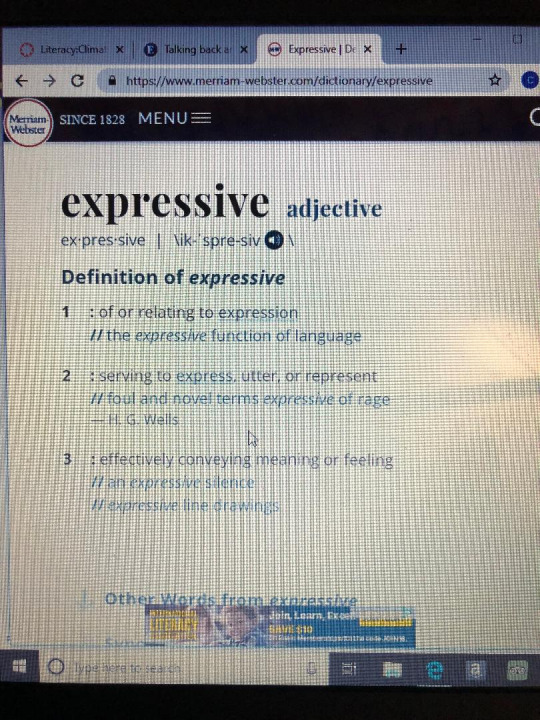
These photos show the process I went through in discovering words that were unclear in a heading and looking them up.
References:
Dictionary by Merriam-Webster: America's most-trusted online dictionary. (n.d.). Retrieved October 18, 2018, from https://www.merriam-webster.com/
1 note
·
View note
Text
Readerly Exploration #7- 10/17/18- Claire Marino
Due Date: 10/17/18
Reading: Shared Reading Article
Highlight excerpts that show the authors purpose
Big Takeaway:
Shared reading can bridge the gap between the enjoyable reading that children experience at home with formal literacy instruction, and thus encourage literacy development that is natural and similar to the way we learn language.
Nugget:
Read alouds in a classroom do not facilitate books becoming “favorite books.” We must encourage this behavior if it is not modeled outside of school.
Exploration:
For this exploration, I chose to look for the authors purpose for writing in the article. The idea of shared reading is one that is somewhat unfamiliar to me, so I was curious about the way the author would present it. This article examined research about the validity of more natural approaches to learning literacy, including those with shared readings. As I went through, I found myself highlighting on almost every single page, uncovering more about the author’s perceived intent for writing this article. In the first few pages, I highlighted excerpts in which Holdaway pointed out that learning, even when it is challenging and stretches us, is an innately enjoyable experience. He points to infants discovering the world as an example. I imagined shared readings being this type of experience; one that stretched the mind and provided pleasure for those participating. I then noticed his reference to language acquisition and how it shouldn’t be very different from the way we learn to read and write. This more natural approach made me think of other methods discussed in TESOL classes that are more based in the natural acquisition of language. These were both important pieces to understanding this article, but his own purpose is stated in the last paragraphs. He states that the purpose was to bring together research about the ideas in this model and to see if it is in fact possible and beneficial for students. He concluded that the research does reinforce these practices, that this model is feasible. Reading the article in this way caused me to stay centered in the meaning behind the paper at the time it was written, rather than the content I should be getting out of it, which I think created a more meaningful connection.

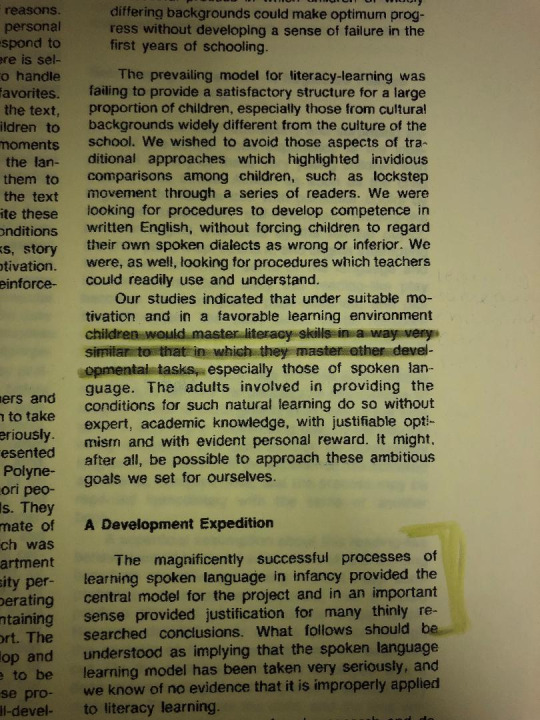
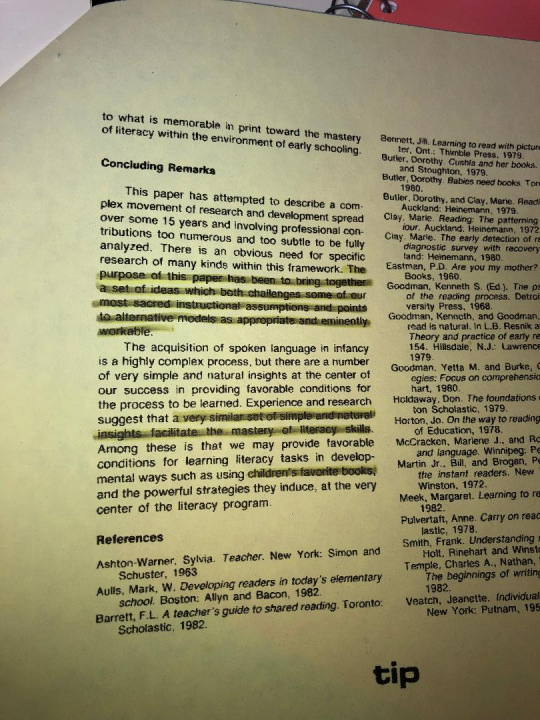
My highlights of the author’s purpose, as it developed throughout the article (and in the order that they came about).
2 notes
·
View notes
Text
Readerly Exploration #6- 10/15/18- Claire Marino
Due Date: 10/15/18
Readings: Richardson Introduction and Chapter 1
Take yourself on a field trip to a place off campus that connects with the big ideas of the assigned readings.
Big Takeaways
(Introduction) The main focus of this section was to inform the reader about what guided reading is and how it is implemented. To summarize, guided reading involves small groups in which the teacher engages students with targeted teaching aiming to improve reading level using instructionally leveled, interesting books.
(Chapter 1) Guided reading fits into a balanced approach for literacy instruction because it seeks to foster independence in reading and writing as well as utilizing a variety of strategies and activities to teach the content.
Nuggets:
(Introduction) Guided reading emphasizes assessments in a different way, by using informative assessments that are meaningful in guiding instruction rather than summative assessments that take away from instruction time.
(Chapter 1) The example of using centers who’s sole purpose is to encourage either reading, writing, or listening showed a way to simply incorporate more holistic aspects of language learning.
Readerly Exploration
For this exploration, I decided to take a “field trip” to a place that connected to the readings. I looked at this reading first when I arrived home for fall break, and knew it would be beneficial to use what I learned from the readings to inform my (already planned) visit to my Mom’s kindergarten classroom. During this visit, I was able to observe the “first six weeks” stage of guided reading that is laid out in chapter 1. We were able to discuss the way she models and builds routine for centers so that she can soon begin pulling groups for guided reading instruction. I watched as she modeled a station where students practiced writing letters in letter books. The center area contained laminated books that had places to practice saying the specific letter and words that start with that letter. It also had pages to practice tracing both the uppercase and lowercase letters. She modeled this station by having the students come around the table for a “gathering,” as she called it, to learn about what to do at their new center. She modeled every part of the books and how she expected them to transition to a new book after they had finished one, and how to ask for help from other students. Afterwards, we discussed the intentionality behind all of the modelling, and how it contributes to the success students had with the centers. Engaging with the text in this way helped me to understand it better by being able to apply the principles and see them in action right away. I am interested to see how guided reading in this class develops and if it aligns with the model this book presents.
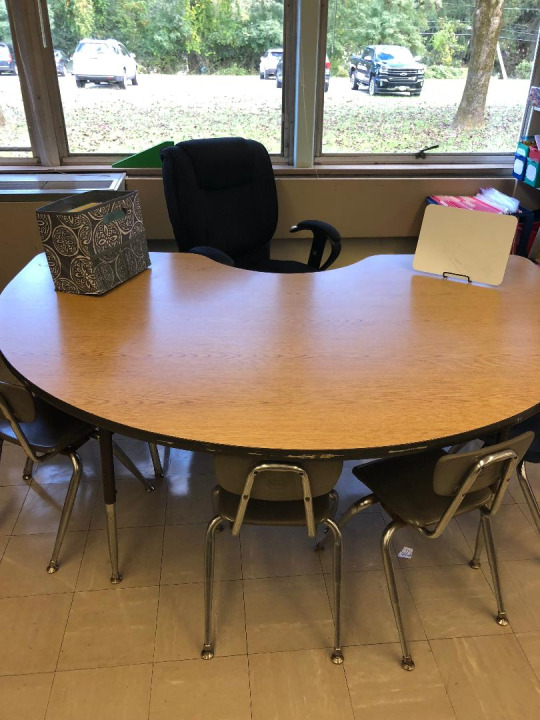
Guided reading area in my mom’s classroom.
2 notes
·
View notes
Text
Readerly Exploration #5- Claire Marino- 10/10/18
Readerly Exploration #5
Due Date: 10/10/18
Readings: Miller Chapter 4 and Worthy
Big Takeaways:
(Worthy) Literacy centers must be intentional and contain a level of teacher supervision in order to be effective for students in early elementary grades.
(Miller) Developing students understanding of their own schemas helps them to create meaningful connections with books, which increases comprehension.
Nuggets:
(Worthy) One of the teachers in an interview discussed how she used centers as something for students to do while small group instruction was happening. This surprised me as it was contradictory to what I have learned about centers so far.
(Miller) When students understand their schemas, they can draw on them to make connections, which can help them develop empathy.
Engage in the reading process to increase the likelihood of text comprehension (pre-reading, reading, responding, exploring, applying) + Choose one resource in the citations of the assigned readings and track it down and read it.
To start this readerly exploration, I began reading both sources, keeping in mind to look out for references to other sources that interested me and needed clarification. When I read Chapter 4 of Reading with Meaning, I found a reference to a work that did just that. On page 82, Miller references Understanding by Design, 2nd edition, which is a book that details a specific instructional format and pedagogy. Her reference was to the six facets of understanding, one of which she felt was accomplished by one of her students. I found this book through our library as an eBook and was able to access the chapter that talked about these facets. As we have learned in many of our education classes, understanding can be a complex idea that is difficult to quantify. So, many different people have opinions about what understanding consists of and how it can be activated, which made me very interested to read this perspective! The facets are can explain, can interpret, can apply, have perspective, can empathize, and have self-knowledge. This made me think of how the model that Miller has presented thus far has aligned with these ideas, as well as frameworks we have learned in other classes. The facets of self-knowledge, explaining, and applying, felt particularly familiar to me as our classes have discussed the importance of making sure students can reflect on their learning as well as being able to apply content to new situations. However, the facets of interpreting and perspective were interesting to me, since I had not directly thought about interpreting them. It says that students must be able to interpret what they learn for meaning, which is an interesting way of describing another way for students to construct their own learning. This also includes making connections to their own experiences, which is just what Miller had described. Perspective involves seeing the big ideas of the content. By understanding these ideas, I felt better about understanding the rest of the chapter and it further solidified the importance of making connections that Miller argued for. I also think that a connection between these facets and the Worthy article can be made, since the stations in the study truly lacked implementation of facets of understanding. Perhaps if these were incorporated into the centers, they would have been more meaningful for students.
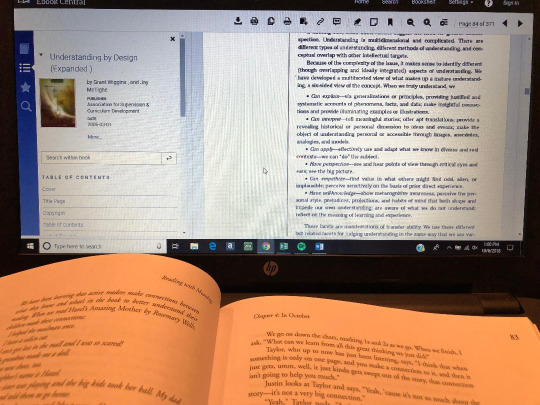
Accessing the eBook and looking through the six facets of understanding.
2 notes
·
View notes
Text
Claire Marino: Simulation Journal #2 Prompt: Due Friday, Oct. 5
Part I.
Within our simulation, your first deadline for your Unit Plan pilot project is fast approaching and you will have to submit Part I to Mrs. Fletcher this week. In your In-Service trainings, she’s been walking you through Messiah School District’s approach to instructional design using the Systems Model and has also begun to explain the district’s instructional plan template bit by bit. However, she hasn’t had time to answer all of your questions and seems to expect that you will complete parts of the Unit Plan before you’ve had a chance to really gain your confidence with the process. Not only that, but she’s asking you to do things for which she never intends to provide professional development for you at all, such as how to design a strong scope and sequence for a thematic unit of study.
Describe how you have felt “giving it a go” when you know there are very real expectations (deadline from your fictional principal and grades from your real professor) and share some things you’ve learned about yourself as a professional as you’ve undertaken this task.
This whole semester has been a transformative, growth focused process for me—even though we are only one month in! In this simulation, we have been asked to do things that we do not have a full handle on yet. This has given me, as an individual, cause for concern every time I encounter it. For most of my classes in college, I have been able to take in information, and show that I have learned that information and can apply it, in that order. Before starting this class, I did not realize how heavily I relied on that sequence for comfort. “Giving it a go,” in Unit Plan part 1 was something that I struggled with. I had so many questions and so many ideas, all the while being completely unsure if my ideas were on the right path of what we intended to learn and produce. Having work days in class where I was unable to get some questions answered caused me to look closer at the resources I had, such as lecture notes about essential content. When I reflect on it though, there is something else that I have learned about myself as a professional. So much about what I believe about education is connected to my belief that students should be free to take risks. Students should be given an environment where taking risks is expected and falling short sometimes is expected and valued. We should give them opportunities to explore their own learning confidently, without fear of grades, disappointment, or other mandates that hold back risk-taking. This experience so far has caused me to look at myself as a learner, and how opposed I am to taking risks in my own life! If I want to model this for my students one day, I need to relish this opportunity to learn and take risks, including trying my best at things when I am not prepared enough to ensure perfection.
Part II.
How does reflecting on our simulation in this way help you think about our course driving question differently? (Driving Question: How can teachers create effective instruction that is good for children and maintains the integrity of their philosophy within the constraints of administrative and other external mandates?)
I appreciate the opportunities embedded in this experience to reflect, because it does drive the purpose back to our driving question and overall goals. I believe this reflection and part of the course connects to the driving question because it challenged me to look at the integrity of my philosophy. It also challenged me to imagine a situation where I feel that the quality of my instruction may be compromised by a lack of support from administrative mandates. I think that a situation, such as creating part 1 of the unit plan, where I would be asked to create something for students that I wasn’t prepared for would cause me to look at my priorities. How do I make sure this instruction is good for children when I feel underprepared to deliver it? Is presenting good instruction valued over doing what an administrator has asked me to do? Or is taking a risk into a territory unknown modeling my own teaching philosophy for my colleagues and students?
Here is a link to an article I read recently that inspired my thinking of facilitating risk taking in the classroom:
https://www.edutopia.org/article/classroom-full-risk-takers
1 note
·
View note
Text
Readerly Exploration #4- Claire Marino- 10/3/18
Due Date: Wednesday 10/3/18
Titles: Reading with Meaning Chapter 2 and 3
Big Takeaways:
(Miller 2) Creating an environment that encourages readerly behaviors and self-confidence in students as readers is just as important as direct literacy instruction, and should be given time as such.
(Miller 3) Students should have ownership over their learning, which means learning classroom procedures for choosing one’s own book, exploring materials, and assessing progress.
Nuggets:
(Miller 2): I loved reading about how our focus for literacy instruction must first address what readers do.
(Miller 3): I had not considered the value of having songs and rhymes for students to use as early reading material, helping them to make connections between word and sound and increase student interest.
Readerly Exploration:
Engage in the reading process to increase the likelihood of text comprehension (pre-reading, reading, responding, exploring, applying) + After you read, document your initial response to what you’ve read. Consider how the ideas you read about made you feel and what they made you think about.
This exploration was my favorite thus far in the class. The topics presented in these two chapters were particularly striking to me, simply for the innovation of ideas and connection to my current field experience. The opportunity to reflect immediately after reading, though, was what made them truly valuable. By thinking about the way the readings made me feel, I was able to draw connections that I wouldn’t have otherwise. The biggest revelation that occurred during these reflections was the impact that the type of writing style Miller uses in this book had on my intake of the information. I found myself feeling enveloped in her examples of real students benefiting from the strategies she used. As I reflected, I realized that I felt this strong connection to the content when these examples were used because it gave me a familiar feeling. I have countless memories of dinners with my extended family and holidays where, after dinner, my family that consists of many teachers, would sit around the table and engage in discussion about their experiences pertaining to education. Between perspectives on new curricula, changes in school regulations, and examples of strategies that worked in their own classrooms, I sat and listened, captivated by the experiences they shared. From a young age, this was one of my favorite parts of family get-togethers and continues to be one to this day. Miller’s writing style mimicked this language for me, and thus placed feelings of excitement for education that are not found in many other readings. This opportunity to reflect made me realize how reading affects me and I have learned more about myself as a reader and an educator because of it.

My response and notes from this chapter.
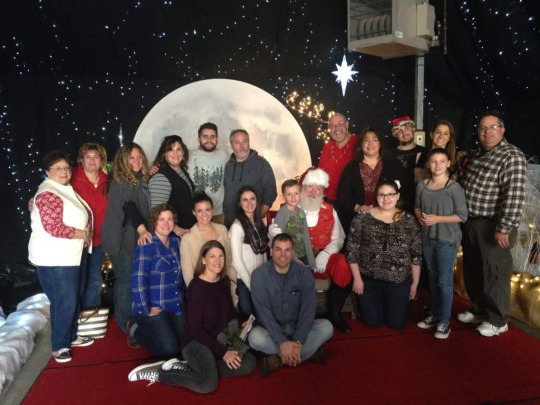
My family who inspired these types of conversations!
2 notes
·
View notes
Text
Claire Marino- Readerly Exploration #3- 9/28/18
Due Date: 9/28/18
Titles: “Building Language and Literacy Through Play,” “Why Children Need Play,” and “Enriching and Assessing Young Children’s Multimodal Storytelling”
Explore relationships with other people through reading by using texts as a shared experience with another person/other people or to gain insight into the perspective of another person
Choose an excerpt from your assigned course reading(s) and share with a family member to get his or her insight and perspective on it.
Take-aways:
(“Building Language and Literacy Through Play,”) If teachers support high-quality play in early education, there is potential to improve language and literacy skills.
(“Why Children Need Play”) There are certain qualities that distinguish unproductive play from play that facilitates learning, and these should be incorporated in early education.
(“Enriching and Assessing Young Children’s Multimodal Storytelling”) Infusing writers workshop with elements of multimodal dramatic play can increase meaning and learning for students.
Nuggets:
(“Building Language and Literacy Through Play,”) We should refrain from intervening in play, but we can still increase the likelihood that it is effective by prepping play beforehand.
(“Why Children Need Play”) The author made an interesting point that first grade and higher grade level teachers don’t expect students to come to their classes having mastered spelling and math facts, but kindergarten and pre-k teachers often expect that students will know how to cooperate and listen, when really, this is something that they need to be taught to do.
(“Enriching and Assessing Young Children’s Multimodal Storytelling”) I loved the connection of a play shop to the effective model of writers’ work shop. I found it interesting seeing how creative and engaged students were for these displays of their work.
Reflection:
For this readerly exploration, I decided to share an excerpt from these readings with a family member to gain their perspectives on it. As I sat across from my mom, who had been visiting for family weekend, I began these readings and realized there was an apt connection between the articles and her experiences. I knew her feedback would be valuable to the topic of the importance of play in literacy development, since I had seen her focus on this all summer in preparation for transitioning to teaching kindergarten from first grade. I showed her an excerpt from “Building Language and Literacy Through Play,” that discussed the importance of creating an environment for play in the classroom. My mom gave examples of how she was able to do this in her classroom, by making distinct dramatic play areas as well as integrating dramatic play into other stations. She has a small area with dress up costumes, a miniature kitchen and table, and a shelf that lends itself to being used as a store window. She also prepared a “building space,” which includes pretend tools, Legos and blocks for students to build with, and construction vests and hard hats to wear. We were also able to talk about the importance of incorporating play into all parts of the day at this age, since it engages students the most. She has started to use a class mascot, “Birdie,” who is a stuffed animal bluebird to teach students about classroom procedures and routines. Students get to watch Birdie get into trouble by not listening to these procedures and correct her behavior as a class. This allows students to engage in dramatic play as a group, even in instructional time. She also engaged in a shared writing with the students about the procedures. This connection was supported by the other two articles, which encouraged this type of interdisciplinary integration of play. “Why Children Need Play” supports the idea that play and academic rigor can not only coexist, but actually help increase performance in school. The idea of integration of play is mirrored in “Enriching and Assessing Young Children’s Multimodal Storytelling”, which brings up the elements of play that are conducive to writers’ workshop. I was able to see my mom’s perspective on play through examples and her teaching philosophy that drove her to create these examples for her students.
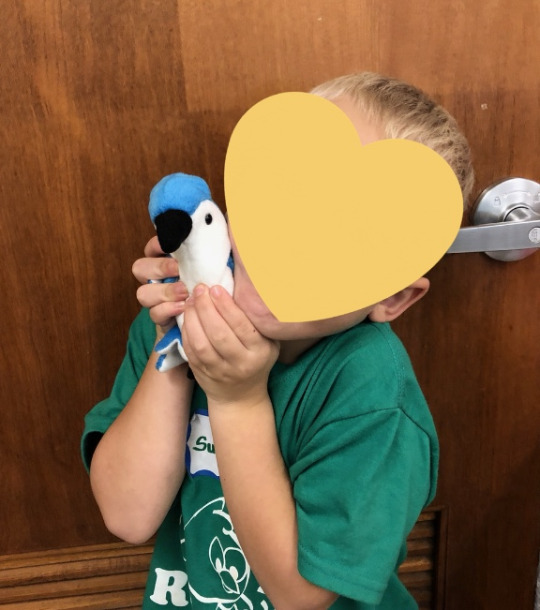
Pictured is a student with “Birdie” the bluebird, and the shared writing that shows the classroom procedures.
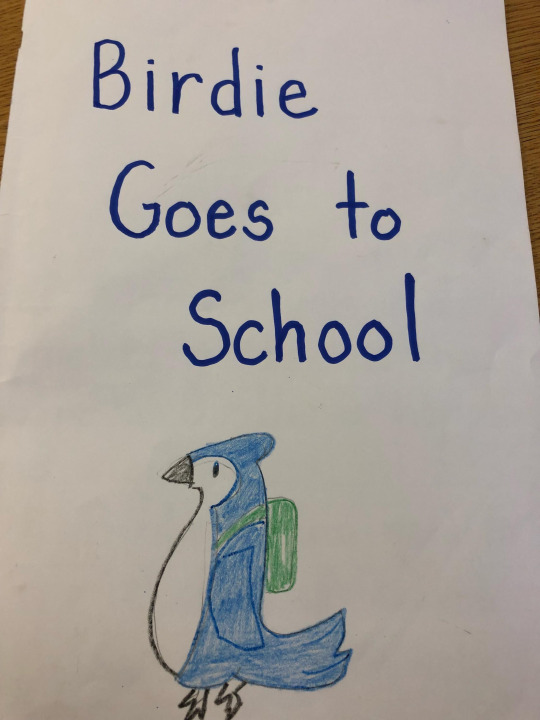

2 notes
·
View notes
Text
Readerly Exploration #2, 9/21/18, Claire Marino
Date: 9/21/18
Titles of Articles: Reading with Meaning Chapter 1, “Reading with a Crayon: Pre-conventional Marginalia as Reader Response in Early Childhood”
Big Take-aways:
(Miller) The main frameworks we use to teach literacy should consist of intentionally created communities built on trust and evidence-based models of teaching so that students can create meaning and build upon literacy skills.
(Fischer) Children’s “graffiti” in picture books during their earliest years of life should not be disregarded, but rather recognized for their potential to document some of a reader’s first interactions with text.
Nuggets:
(Miller) I had never considered the discussion of over-scaffolding that was brought up in this chapter. When we try so hard to get every student “on-track” by adjusting their own learning for them, we can actually be denying them the learning opportunity that comes with thinking behind ensuring their success.
(Fischer) The thing that stuck out most to me was the idea that we formally teach methods of annotation in school to promote comprehension after stifling the same instinct that was present in the same students years earlier.
In order to learn more about the authors of these readings, I began to research their backgrounds in education. I discovered that Debbie Miller taught in Denver Public Schools for 30 years, in addition to writing books like Reading with Meaning for teachers. She currently presents at workshops around the country and internationally and helps districts plan literacy programs. I also watched an interview of Debbie Miller in which she explains the updates in the new edition of this book. In addition to understanding her background as a teacher, hearing her testimony about being a teacher who is constantly reflecting on her own practice and growing in new ways gave me insight into the purpose of this section of the book. I was also able to put a face with the mentor-like advice that is woven into the chapter, which made it even more meaningful. I was able to connect the interview to the text specifically when she discussed the idea of gradual release. In the interview, she expressed that this was a new development for her as an educator, and a deviation from the linear model of release that she had always followed. This made me reflect on my own ideas about release of responsibility and how a linear model has been used throughout my own education experience. My research into Dr. Sarah Fischer’s background included my own personal experience, since she is my professor for this and other teacher preparation courses. She is a professor of literacy education at Messiah College and has completed other research of topics such as place-based education. This helped me to understand the purpose of this research more deeply and how it connects to the principles taught in Miller’s guidelines for teaching literacy. Both discuss the importance of ownership, in proprietorship over reading materials and in the independence of classroom learning, in the lives of young students as they develop in literacy.
youtube
References:
S. (2012, December 07). Retrieved September 15, 2018, from https://m.youtube.com/watch?v=gDaMz-2pJH0Debbie
Miller. (n.d.). Retrieved from https://www.stenhouse.com/authors/debbie-miller
1 note
·
View note
Text
Instructional Design: Simulation Journal, 9/14/18, Claire Marino
Part I.
Now that you’ve made it through your New Teacher Orientation in our simulation, talk about an instance in which what is expected of you in this district might be at odds with your teaching philosophy and/or an instance in which what the district says they believe might be at odds with how things are actually run.
During the simulation, I originally believed that most things Principal Fletcher talked about were aligned with my views and philosophies of teaching. Although previously I have not been required to do a high degree of lesson planning, I do believe in its importance and look forward to exploring this side of teaching. However, on the last day of New Teacher Orientation, Principal Fletcher discussed how teachers were evaluated and how much of that evaluation is drawn from student performance on tests. Previously, she had spoken about how the district does not want teachers teaching to the test. I felt that this did not match the actual practices that will be put in place, as it is heavily dependent on testing. This also conflicts with my own beliefs, as I fully believe that there are dangers to overusing standardized assessments in an environment where one wishes to teach holistically.
Part II.
How does reflecting on our simulation in this way help you think about our course driving question differently? (Driving Question: How can teachers create effective instruction that is good for children and maintains the integrity of their philosophy within the constraints of administrative and other external mandates?)
This part of the simulation made me consider a possible scenario that I might encounter as a teacher. In many schools today, emphasis is being put on student performances on tests. I believe this is not only problematic to the student but also the teacher, as it doesn’t take into account important factors when evaluating performance such as different learning styles and ways of showing learning. It has made me consider how this situation would present a dilemma concerning staying true to myself. I am definitely considering the balance that I would have to strike between preparing students for these inevitably important exams while still appreciating the child as a whole and making sure they know that it does not define their worth. I will carry this question with me as I continue throughout this class and in field experience to seek out how other professionals find this balance.

1 note
·
View note
Text
Readerly Exploration #1- 9/14/18
Name: Claire Marino
Due Date: 9/14/18
Titles of Readings: “Building a Literacy Community: The Role of Literacy and Social Practice in Early Childhood Programs” and “Toward an Educationally Relevant Theory of Literacy Learning: Twenty Years of Inquiry”
Big Takeaway:
(Meier) Making learning literacy a social part of life, through encouraging ownership and thinking processes, increases its relevance in the lives of preschool students as well as in the lives of parents and families.
(Cambourne) The discrepancy between some students’ success in outside of school learning and inside of school learning can be credited to the way literacy is taught apart from the natural conditions necessary for learning. If we can replicate these conditions for learning, we will be helping students to be successful in school.
Nugget:
(Meier) I was surprised and challenged by the way the examples showed teachers answering a question with a question at such a young age. It states that “the aim was to help children construct their own ways of coping with their world by affecting it with their thought, action, and language” (Britsch & Meier, 1999). This statement tied together the way this type of response can increase self-efficacy and coping skills in students.
(Cambourne) One thing that surprised me in this article was the learning theory that Cambourne referenced that his teaching was initially based on. Specifically, that learners are too immature to direct their own learning in any way, so teachers must make all decisions about learning. I thought this contrasted with some current trends in teaching that involve students having increased autonomy over learning.
The task that I chose to do for these readings fell under the readerly habit, “Engage in the reading process to increase the likelihood of text comprehension (pre-reading, reading, responding, exploring, applying).” I chose this task because, at first glance, the titles and abstracts of the two articles did not draw on content I felt familiar with, so I suspected I might have questions concerning comprehension. I chose to annotate any questions that came up in the margins. First, I read through and underlined parts of the reading that were confusing or interesting and then formulated questions about them. After writing them in the margins and completing the article, I went back and thought about possible answers. I think this helped me in my own understanding of the articles’ content as it forced me to think about the parts of the reading that confused me, rather than just skimming over them. For example, in both articles, statements in the very beginning caused me to wonder when they had been written, as it seemed slightly out of touch with more modern education readings. This prompted a search for context, which helped me draw parallels between the educational climate at the time they were written compared with today. It also helped me pursue what did interest me, rather than the brief moment of interest that often occurs when reading, followed by, again, continuing to read unscathed. By writing these questions down, I had to think deeper into the implications of these statements in the readings. One example of this was from the Britsch and Meier article, when students were encouraged, through questioning, to make their own decisions and solve their own problems. I wrote my question, “How does this type of language affect rapport with students?” This prompted me to think about a classroom where answers weren’t just given out for the sake of saving time, but were concluded to with the help of students. This way they could feel proud and have ownership over solving problems. I truly believe that this has helped me comprehend both articles better and will help when it comes to implementing this material in real teaching experience or in class.
References:
Britsch, S. J., & Meier, D. R. (1999). Building a Literacy Community: The Role of Literacy and Social Practice in Early Childhood Programs. Early Childhood Education Journal, 26(4), 209-215.
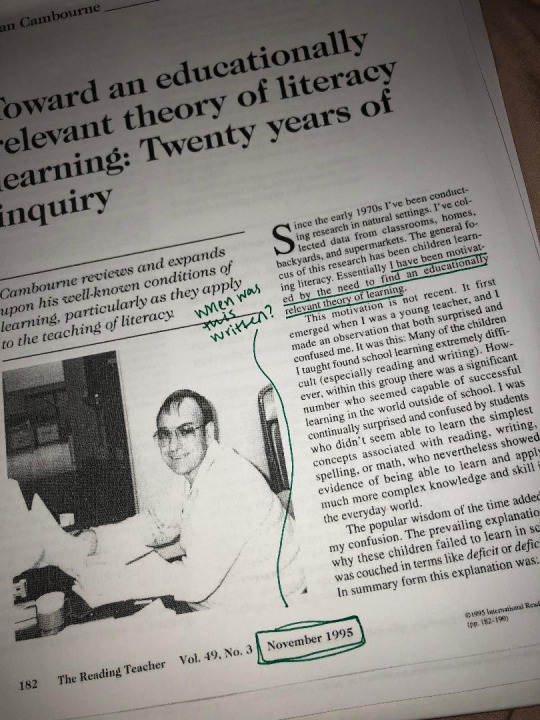

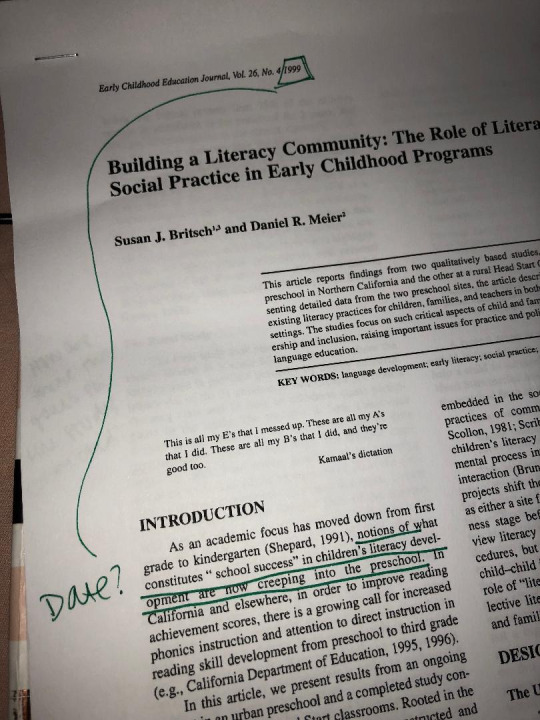
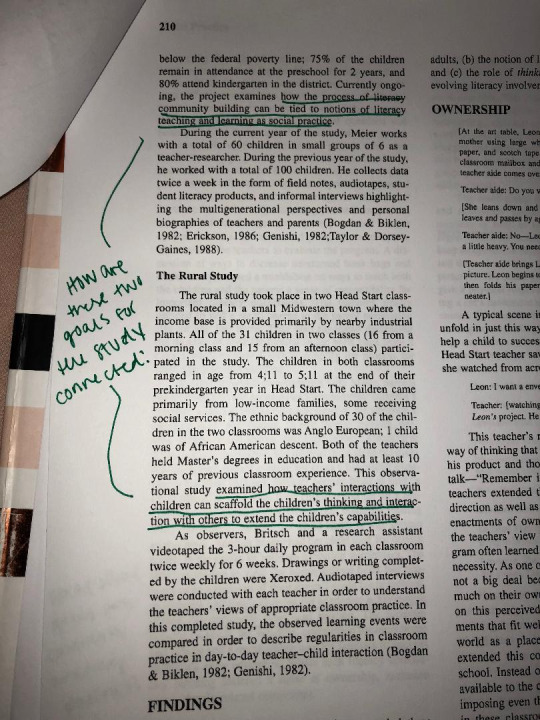

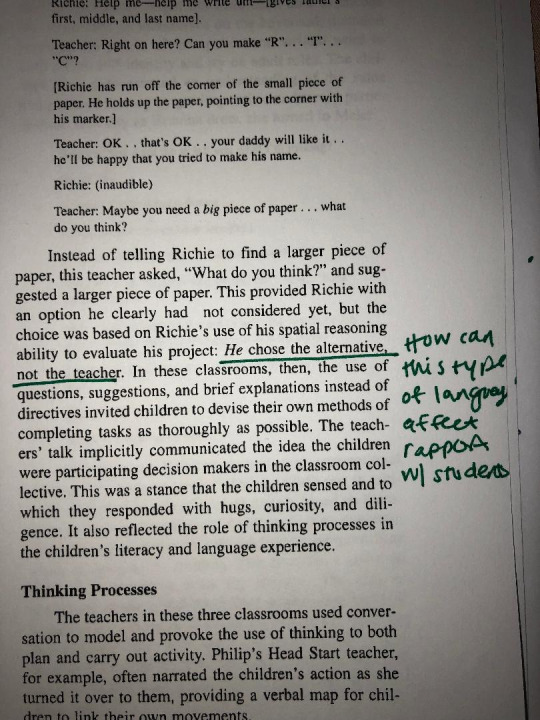
1 note
·
View note